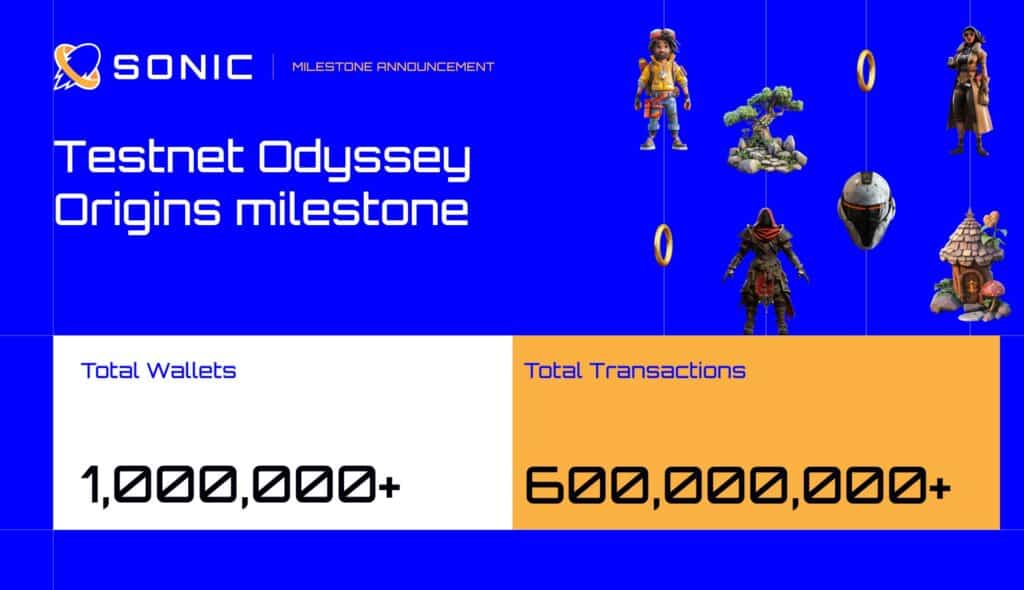Sonic’s testnet surpasses one million users, marking a significant milestone in Web3 gaming. The article explores the role of rewards, soft infrastructure, and Solana’s impact, while addressing challenges in mainstream adoption
Sonic, the first gaming-focused Solana Virtual Machine (SVM) layer 2, recently achieved a significant milestone by surpassing one million monthly active users during its testnet phase. The platform generated over 600 million transactions, marking a notable achievement in the expanding realm of Web3 gaming.
This surge in user activity was primarily driven by Sonic’s Odyssey testnet campaign, which incentivized participation through rewards. The campaign offered users ‘rings’ for completing tasks and engaging in transactions on the testnet, contributing to the platform’s rapid growth.
Odyssey Campaign’s Role in User Growth
The Odyssey campaign played a crucial role in attracting users to Sonic’s testnet. By offering rewards for specific actions, Sonic encouraged a high level of participation. Chris Zhu, CEO of Sonic SVM, explained the strategy behind the campaign in an interview with news reporters: “Users are rewarded ‘rings’ for transacting on the testnet and completing certain tasks. The tasks also include things like completing actions within our ecosystem games.”

Sonic’s testnet provided users with eight games, including popular titles such as Rage Effect, LowLifeForms, and JogoJogo. JogoJogo, a prediction-based game, was particularly successful, registering over 250,000 participants. This diverse range of games helped to sustain user engagement and contributed to the platform’s overall success during the testnet phase.
Importance of Soft Infrastructure
While the technical framework of a gaming platform is essential, Sonic’s success highlights the importance of what Zhu refers to as “soft” infrastructure. In the context of Web3 gaming, this includes go-to-market strategy support, project bootstrapping services, and post-launch marketing efforts.
“We recognize that what makes a game successful is not only determined by its technicalities — the ‘soft’ infrastructure we provide is designed to enhance and raise awareness for not just our individual games, but Web3 gaming on Solana as a whole,” Zhu said. Sonic’s approach to supporting game developers is seen as a key factor in its growth.
Sonic’s recent financial success also underscores its potential within the Web3 gaming space. The platform closed a $12 million Series A funding round led by Bitkraft Ventures, bringing its total capital raised to $16 million. This funding is expected to support Sonic’s continued development and expansion efforts.
Challenges in Web3 Gaming Adoption
Despite Sonic’s achievements, the broader adoption of Web3 gaming faces significant challenges. One of the primary obstacles, according to Zhu, is the need for more education about the differences between Web2 and Web3 gaming economies. Web3 games, which operate on play-to-earn models and player-owned economies, represent a shift from traditional gaming structures, which can be difficult for mainstream gamers to fully understand.

“The biggest issue for mainstream adoption is an inherent difference in the economies created in Web2 games vs. Web3 games. A lot more education needs to be done regarding Web3 games, as well as building interesting and engaging platforms that gamers will enjoy,” Zhu noted. This educational gap is a critical challenge that platforms like Sonic will need to address to achieve wider adoption.
Solana’s Growing Role in Web3 Gaming
As Sonic continues to develop, it is becoming evident that Solana is emerging as a prominent blockchain for Web3 gaming communities. Zhu emphasized Solana’s strengths, noting its ability to meet the demands of Web3 gaming effectively. Other blockchain networks popular in the gaming space include Ronin Network, which hosts Axie Infinity, as well as Immutable X, MultiverX, Oasys, and Polygon.
Sonic’s testnet success reflects a broader trend in the rise of Web3 gaming, underscoring both the opportunities and challenges in this emerging field. As the platform continues to grow, the focus will likely remain on addressing the educational needs of mainstream gamers while leveraging Solana’s capabilities to support further innovation in gaming. Sonic’s journey suggests that while the road ahead may be challenging, the potential rewards for successfully navigating this new landscape are substantial.





























